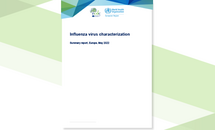Influenza virus characterisation - Summary Europe, September 2021
This is the 10th and final report for the 2020-2021 influenza season. As of week 39/2021, only 1 276 influenza detections across the WHO European Region were reported to TESSy; 60% type A viruses, with A(H3N2) (85%) dominating over A(H1N1)pdm09 (15%), and 40% type B viruses, with only 16 having been ascribed to a lineage, 15 B/Victoria and one B/Yamagata. This represents a 99.2% drop in detections compared to the 2020-2021 season, probably due to the COVID-19 pandemic and measures introduced to combat it.
Executive Summary
This is the 10th and final report for the 2020-2021 influenza season. As of week 39/2021, only 1 276 influenza detections across the WHO European Region were reported to TESSy; 60% type A viruses, with A(H3N2) (85%) dominating over A(H1N1)pdm09 (15%), and 40% type B viruses, with only 16 having been ascribed to a lineage, 15 B/Victoria and one B/Yamagata. This represents a 99.2% drop in detections compared to the 2020-2021 season, probably due to the COVID-19 pandemic and measures introduced to combat it.
Since the July 2021 characterisation report1, two shipments from EU/EEA countries (the Netherlands and Norway) containing three virus isolates were received at the London WHO Collaborating Centre, the Francis Crick Worldwide Influenza Centre (WIC). This report therefore focuses on genetic characterisation of HA genes of representative seasonal influenza viruses submitted and/or released in GISAID up to 31 August 2021, together with sequences recently determined at the WIC. The new genetic clade nomenclature system proposed during the course of the September 2021 VCM is indicated in red in this summary and the most recent HA gene phylogenies. The data continued to show extremely low levels of influenza detections globally. However, there were a number of detections reported to TESSy since week 36/2021 which could indicate an early start to the 2021-2022 influenza season in the WHO European Region.
While the majority of A(H1N1)pdm09 detections have been in the 6B.1A5A+187V/A (6B.1A.5a.1) subgroup, represented by the vaccine virus for the northern hemisphere 2020-2021 season, A/GuangdongMaonan/SWL1536/201960, recent detections of 6B.1A5A+156K (6B.1A.5a.2) viruses have been reported in India. A/Victoria/2570-like and A/Wisconsin/588/2019-like (6B.1A.5a.2) viruses have been recommended respectively for egg- and cell-based vaccines in the 2021-2022 northern and 2022 southern hemisphere influenza seasons.
The great majority of recently detected A(H3N2) viruses have fallen in subgroup 3C.2a1b+T131K-A (3C.2a1b.2a), being split between Cambodia-like (3C.2a1b.2a.1) and Bangladesh-like (3C.2a1b.2a.2) viruses. A/Cambodia/e0826360/2020-like (3C.2a1b.2a.1) viruses were recommended for use in the 2021-2022 northern hemisphere season, while A/Darwin/9/2021-like and A/Darwin/6/2021-like (3C.2a1b.2a.2) viruses were recommended for egg- and cell-based vaccines in the 2022 southern hemisphere season. Recently detected viruses in the Netherlands and Norway were Bangladesh-like (3C.2a1b.2a.2) genetically and antigenically.
The vast majority of B/Victoria-lineage HA sequences derived from viruses collected after 31 January 2021were subclade 1A(3)B (V.1A.3), represented by B /Washington/02/2019, the vaccine virus recommended for inclusion in influenza vaccines for the 2021-2022 northern hemisphere season. The vast majority of these viruses have fallen in the HA1 N150K, G184E, N197D and R279K amino acid substitutions group (V.1A.3a) being split between the HA1 V117I and V220M (V.1A.3.1) and HA1 A127T, P144L and K203R (V.1A.3.2) subgroups, with the latter subgroup showing the greatest geographic spread. B/Austria/1359417/2021-like (V.1A.3.2) viruses have been recommended for use in the southern hemisphere 2022 influenza season. Antigenically, viruses in subgroups of the V.1A.3a group differ and show some loss of reactivity with post-infection ferret antisera raised against B/Washington/02/2019. The V.1A.3.2 virus from France detected in July and characterised here clearly shows good reactivity with post-infection ferret antisera raised against B/Austria/1359417/2021 and poor reactivity with antisera raised against B/Washington/02/2019.
No B/Yamagata-lineage HA sequences from clinical specimens collected in 2021, and none with collection dates after March 2020, were available. All of the 77 sequences from viruses detected in 2020, inclusive of 12 from EU/EEA countries, belong to genetic clade 3 (Y3)and carry three HA1 amino acid substitutions (L172Q, D229N and M251V) compared to B/Phuket/3073/2013-like viruses which have been recommended for use in quadrivalent influenza vaccines for the 2020-2021 and 2021-2022 northern hemisphere seasons and 2021 and 2022 southern hemisphere season. The antigenic effects of these amino acid substitutions have been minimal as assessed in earlier reports
Download








